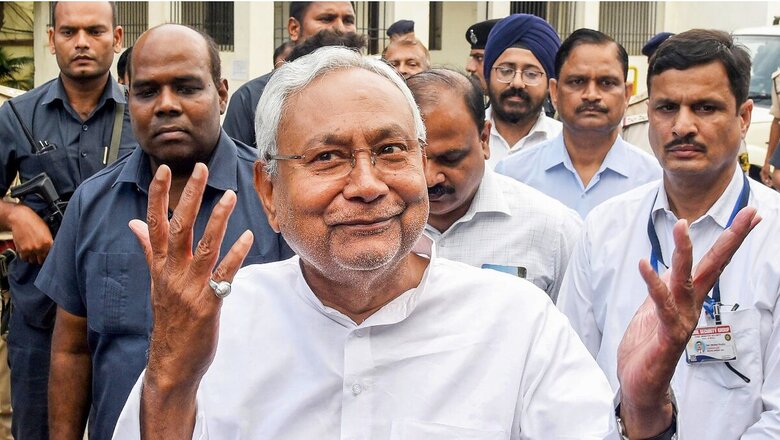
views
The caste survey released by the Bihar Government on Monday revealed that Other Backward Classes (OBC) and the Extremely Backward Classes (EBC) constitute 63 per cent of the total population in the State. Together with the Scheduled Caste (SC) and Scheduled Tribe (ST), which constituted 19.65 per cent and 1.68 per cent respectively, the population under the “reserved category” stood at around 85 per cent.
As per a Supreme Court ruling in 1992, reservations for the backward class in government jobs and educational institutions cannot be more than 50 per cent.
But, with the new numbers released in the Bihar caste survey, the ceiling might get challenged in the court. The 50 per cent ceiling on reservations in jobs and educational institutions was endorsed by the Supreme Court in the Indra Sawhney vs. Union of India case in 1992.
Mandal Commission
In 1979, then Prime Minister Morarji Desai fulfilled his electoral promise and constituted a commission on backward classes under the chairmanship of BP Mandal, who was former Chief Minister of Bihar.
The commission was tasked with determining criteria for defining socially and educationally backward classes, recommending the steps to be taken for their advancement, and examining the need and desirability of making provisions for reserving appointments/posts in favour of such classes of citizens.
The commission found that there were 3,743 socially and economically backward castes, 50 per cent higher than what the first backward class common had found. Depending on the caste census of 1931 and population census of 1971, the Mandal Commission concluded that OBC constitutes about 52 per cent of the population of India.
There was already a 22.5 percent reservation for SC and ST and introducing 52 per cent reservation for OBCs to match the population percentage would be in contravention of many landmark cases of the apex court.
In 1963, in the landmark MR Balaji vs. Mysore, the court had put a 50 per cent limit on reservations. So, the commission decided to provide a 27 per cent reservation to OBC.
However, the commission recommendation was not implemented at that time. It was resurrected a decade later by then-Prime Minister VP Singh who decided that his government would go ahead with it.
Indra Sawhney vs Union of India
Indra Sawhney vs Union of India is one of the most important cases of independent India that was filed by a journalist named Indra Sawhney.
Zia Mody, in her book ’10 Judgements that Changed India’ explaining the backdrop of the Indira Sawhney case, writes: “Two office memorandums were issued to implement some of the Mandal Commission’s recommendations relating to public employment. Read together, the memorandums had the following import: 27 per cent of the civil posts under the Government of India would be reserved for OBCs. Among the backward classes, preference would be given to the poorer sections.”
“If, after giving first preference to poorer sections, there were still vacancies, these could be filled by the others within the backward classes. However, OBCs recruited on the basis of merit would not be adjusted against the 27 percent quota. Finally, 10 percent of the vacancies would be reserved for other economically backward sections uncovered by existing schemes of reservations,” she adds in the book.
Indra Sawhney, a journalist, filed a public interest litigation (PIL) stating that the memorandums were not constitutionally valid. This PIL was clubbed with several other writ petitions challenging the constitutionality of the memorandums under Article 16 of the Constitution.
A nine-judge bench of the Supreme Court, which was the largest bench ever constituted at the time, sat in judgment over the constitutionality of the office memorandums and the constitutional boundaries of India’s reservation policy in general.
Outcome of the case
The Mandal Commission Case laid down certain guidelines and clarified a few points regarding Article 16(4).
Article 16 (4) states: Nothing in this article shall prevent the State from making any provision for the reservation of appointments or posts in favour of any backward class of citizens which, in the opinion of the State, is not adequately represented in the services under the State.
The court held that the reservation contemplated in Article 16 (4) should not exceed 50 percent and is confined to initial appointment only and cannot extend to providing reservation in the matter of promotion. However, Parliament later added Article 16 (4A) which permitted reservations for SCs and STs in promotions.
The judgment made it clear that backward classes of citizens are not defined in the Constitution and there is an integral connection between caste, occupation, poverty, and social backwardness. In the Indian context, lower castes are treated as backward. A caste may by itself constitute a class.
According to DD Basu, the judgment made it clear that backward classes can be identified in Hindu society with reference to castes along with other criteria such as traditional occupation, poverty, place of residence, lack of education etc, and in communities where caste is not recognised the rest of criteria would apply.
The court clarified that backwardness contemplated by Article 16(4) is mainly social. It need not be both social and educational.
The judgment held that the identification of backward classes is subject to judicial review.
Creamy layer
Zia Mody writes that “One of the most serious concerns surrounding the policy of reservation was ensuring that advanced or prosperous members of the backward classes (upper crust) did not exploit the system intended to benefit destitute and the disadvantaged”.
The judgment held that those who form the “creamy layer” of the OBC should be excluded from reservation benefits.
The most important takeaways from the Indra Sawhney case were: it clarified “backwardness, reiterated the 50 percent rule and introduced the concept of the creamy layer.


















Comments
0 comment